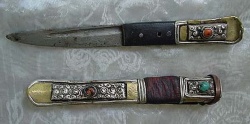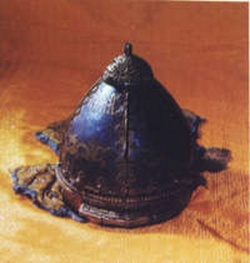Prehistoric Culture of Tibet
Exhibits in the Tibet Museum demonstrate the stages of development of prehistoric culture, although academics are still debating the dating of the prehistoric period. Scholars are divided over the dating of the palaeolithic: some believe that the exhibits on view in the Tibet Museum support the theory that the palaeolithic can be dated to 50,000-10,000 years BP, while other suggests that it should be dated to circa 10,000 years BP. There are also three different opinions with regard to the neolithic:
During the mesolithic the local people began to produce stone chips, and on this basis made other kinds of stone tools that are unique to this period.
The skills required to make stone tools were introduced from north China; and,
The skills required to make stone tools were introduced from south China.
The official opening of the Tibet Museum took place on October 5, 1999. The exhibits in the museum are divided into four parts: "Prehistoric Culture," "Inseparable History," "Culture and Art" and "Folklore." The following is a brief introduction to the first part: "Prehistoric Culture." The prehistoric development of mankind is divided according to the type of production tools used into the palaeolithic, the mesolithic, the neolithic; the Bronze-neolithic (the Red Age), the Bronze Age and the Iron Age.
? THE PALAEOLITHIC.
Archaeological finds reveal that the Tibet Plateau was inhabited tens of thousands of years ago. Early man lived by hunting and gathering, and made and used stone tools.As agriculture, pottery making, ground stone tools and the raising of domestic animals in the river valleys developed, human society entered the neolithic. Since 1951, eight late palaeolithic sites related to the ancestors of the Tibetans have been discovered, and have been dated to 50,000-10,000 years BP. Most of these sites are located in the north and west of the Tibet Autonomous Region, and the others in the south. All lie at an elevation of 4,100-4,800 meters. The museum's "Prehistoric Culture" exhibit includes axes, scraping and cutting tools and stone hammers. They were found on the northeastern bank of the Xardai Co Lake in Rutog, Ngari Prefecture. The neolithic is dated to 10,000-3,000 years BP, and can be divided into two types: A cultural type based on farming, livestock breeding and hunting which existed in the river valleys. Representative sites include the Karub and Xiao'enda sites in Qamdo, the Qoigung site in Lhasa, and the Qamgorgo site in Gunggar in the middle reaches of the Yarlung Zangbo River. During this period, the ancestors of the Tibetans grew crops that could withstand drought, made pottery and ground stone tools, raised domestic animals and built houses of mud and stone.
A cultural type based primarily on hunting which existed mainly in the northwestern part of the Tibet Plateau. Major sites include those at Ngari and Nagqu and in the upper reaches of the Yarlung Zangbo River. Based on their location, these cultural types can be sub-divided into the "Karub type," "Qoigung type," "Nyingchi type" and "northwestern Tibet type." Major sites include Gar County, and Zongba, Sagya and Ang'ren Counties in Ngari. More than 90 neolithic tools are on display in the museum, and they have been divided into five groups: l Stone tools, including approximately 20 stone hammers, chips, blades and drivers; l Production tools found at the Karub site in Qamdo in 1981, at the Xiao'enda site in Qamdo in 1986, and at the Qoigung site in Lhasa in 1990. The 28 tools include stone hoes, chisels, knives, spinning wheels, and hammers, and bone needles, awls and combs; l Implements for daily life which were also found at the Karub, Xiao'enda and Qoigung sites. The 30 or so items include black pottery basins, long-necked pottery jars, pottery cups, twin-bodied pottery pots and pottery axes; l Ornaments, a total of 10 items, including square objects, stone rings, and bone beads; and, l Various objects used in social life, such as clay bricks, cereals and carbonized qingke barley.
THE EARLY METAL AGE.
This period is dated from circa 3,000 years BP to the 6th century BP. A willow leaf-shaped bronze object and a bronze mirror with a handle, both from the Qoigung ruins in Lhasa, are symbolic of this period and were produced some 3,000 years ago. During this period, the antecedents of the Tibetans left behind rock paintings, stone architecture, stone coffins and stone tombs. On view are stone coffins unearthed from the ruins in Nyingchi, Qamdo and Lhasa as well as almost all the rock paintings found throughout the region.

